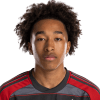Ok, it’s time to start ramping up our countdown-to-first-kick coverage, and rolling out our suite of season preview content before the Feb. 21 opener (and then Feb. 24 openers, plural). Here is the first from me, my annual look at each team’s most likely potential breakout player.
Bear in mind I have no real idea which players are going to get the call and answer the bell, especially since the Primary Transfer Window doesn’t close until April 23 – a few of these guys might not even be regulars by the time this winter’s wheeling and dealing is all said and done. So a lot of things can and will change, but it remains a fun thought exercise to look at each team's roster and try to identify some hidden gems, or guys about to make The Leap.
Per usual, I'm automatically ruling out first-year players and Designated Players for what I feel are obvious reasons. Western Conference was yesterday and the Eastern Conference is below. Reverse alphabetical order by club for fun.
Why he’ll break out: Talent. Period.
Part of me is saying “Oh god, oh god why did I start with Toronto” and another part of me is saying “Hey, this really could be the year for Marshall-Rutty!”
Five years ago, I had smart folks in the academy system telling me Marshall-Rutty was hands-down the best Canadian prospect and he was damn near at Gio Reyna’s level. Fast forward to today and all he is as a pro is a toolsy kid who doesn’t really have a position.
Luckily, TFC are amid a massive teardown and rebuild, and have about a half-dozen positions that need filling. Let’s hope he gets – and grabs – a chance.
What’s his upside this year: Competent starter at one spot or another. I don’t think it’s fair to ask more than that.
Why he’ll break out: Excellent engine + very good athleticism + very good ball-striker + very good fit as a second forward.
I never really saw it with Sullivan until the tail end of last year, and I’ll admit I probably missed seeing it because I was looking for either a winger or an attacking midfielder and he’s not really either (not good enough 1v1 to be a winger, and not a pure enough chance creator to be an attacking midfielder).
But where he does fit is as a sort of 9-and-a-half, a guy who can play off a true center forward and flare out wide or drop in to help combine. He added real value to the Union attack in autumn whenever he got on the field to do stuff exactly like that, and given Philly’s #PlayYourKids approach, I’d expect to see more of the same in 2024. And more often.
What’s his upside this year: If/when Julián Carranza gets sold this summer, I don’t think it’s outside of the realm of possibilities that Sullivan slots in as his replacement in the starting XI.
Why he’ll break out: Oscar Pareja’s teams, at their best, generate a ton of both possession and chance creation from their fullbacks. Once Dagur Dan slotted in at RB last year, the whole team got a bump.
I kind of think he already broke out, but since he’ll be playing right back from the start this season, I wouldn’t be shocked if people outside of central Florida suddenly developed an appreciation for how much value this guy adds on the ball. It’s to be expected at least a little bit, right? After all, he’s a converted midfielder, and the reason you convert a midfielder to right back is because you want one more guy on the field who can conduct the game at least a little bit.
That’s Dagur Dan to a tee.
What’s his upside this year: A bunch of jerks on Extratime shouting for him to be in the Best XI, and then him not making Best XI because fullbacks basically never make it.
Why he’ll break out: Ngoma can contribute on either wing, as a second forward or leading the line as a No. 9. That flexibility puts him in a good position to get on the field for a team with lots of question marks.
Injuries robbed Ngoma of his 2023 season, which is a shame because the Red Bulls could really have used a guy like this:
Ngoma’s a mobile two-way attacker who usually makes the right decision in the attacking third, and doesn’t waste time with any east-west play. For other teams that might be an issue, but for a Red Bull team that is always going direct, it’s absolutely an asset.
What’s his upside this year: I could see him winning a regular spot that gets him on the field for 2,000 minutes across all competitions, with 8-10 goal contributions.
Why he’ll break out: He seems to have won the starting job heading into the season.
O’Toole came into the league as an attacker, started earning minutes as a kind of left wingback in mid-2022, and converted fully into an attacking left back by the middle of 2023. Come the stretch run, when the Pigeons played their best ball of the year, he was officially the starter.
I thought NYCFC would import a new, young South American to replace him this winter, but nope. And by all accounts, it’s not because they’re keeping their powder dry. Rather, it’s because O’Toole has been super convincing in his minutes thus far, both last year and in preseason.
At this point he’s won the job.
What’s his upside this year: Solid starter who adds to the NYCFC attack with his engine on the overlap.
Why he’ll break out: With his first touch as a USMNT player, he laid waste to some poor sucker with a backheel nutmeg. C’mon.
Caleb Porter doesn’t typically play the kids, so I don’t actually expect Esmir to break out. And truth be told, New England’s roster is so stacked that they don’t really have any good potential breakout candidates – it’s all proven guys except for Giacomo Vrioni, who is a DP and is thus not eligible for the breakout tag.
But I’ve got to name someone and Esmir was impressive enough against Slovenia to get the nod.
What’s his upside this year: If he plays 1,000 minutes across all competitions, that’ll be a win. And what I’d look for as the key number from those minutes will be chance creation – i.e., can he turn his on-ball skill into chances for the guys around him?
Why he’ll break out: A ball-playing CB who seemed to win the starting job outright during Leagues Cup.
It doesn’t show up in the numbers yet, but MacNaughton’s got a level of comfort on the ball – and in playing line-breaking, progressive passes – that Nashville desperately need if they’re going to evolve their system away from back-foot-and-counter and into something more modern. They must get that from the backline given the departure of veteran d-mid Dax McCarty – a ball-progression maestro – via free agency in the offseason.
MacNaughton’s not exactly Robin Jansson out there in terms of his ability to hit those passes, but he’s probably the best of the bunch among Nashville’s center backs, and based upon what we saw from him last year, the job’s probably his to lose.
What’s his upside this year: A regular starter who pushes his way fully into the Canadian men’s national team set-up.
Why he’ll break out: Do-everything No. 8 who was dominant in the USL Championship for San Antonio last year.
Zouhir wasn’t in line for real minutes with Montréal last year, and the club doesn't field an MLS NEXT Pro team. So Montréal did something very smart in loaning him out to San Antonio, where he produced 8g/4a in about 1,800 minutes. He was at his best with these types of late-arriving runs:
I’m not sure there’s a clear path to playing time in Montréal this year, but Zouhir has the talent to win a job outright.
What’s his upside this year: A 99th percentile outcome would be winning the starting No. 8 role over the likes of Mathieu Choinière and Nathan Saliba, but a more modest target would be 1,500 minutes across all competitions and a half-dozen goal contributions.
Why he’ll break out: He’s the MLS record signing for a CB. And man, do Inter Miami need him to be good.
Avilés arrived in the middle of last season. You might’ve heard mention that Miami made some moves around then. I forget who the other guys are.
It was a rough intro to MLS for the 19-year-old Argentine, who struggled with the pace and physicality of the league, especially in the box (he was often manhandled by center forwards a decade or more older than him). The flip side is he showed real promise reading the game behind Sergio Busquets, which is a must if Miami are going to be the type of ball-dominant team that doesn’t completely fall apart any time there’s a turnover. It’s really got to be 10 guys reacting as one (and the 11th drifting out in the right halfspace, which is a totally fine and worthwhile risk to take).
What’s his upside this year: I didn’t see anything that said Avilés could jump straight from 2023 struggles to 2024 Best XI. But when you’re the most expensive CB in league history, you should, in fact, be in the Best XI convo at some point.
Why he’ll break out: He was awesome down the stretch last year and looks like a surefire starter next to Christian Benteke up top.
The Ku-DiPietro propaganda will continue until morale improves.
What’s his upside this year: Could he put together a 12g/7a season as a starter at the second forward slot? I think so!
Why he’ll break out: He’s too talented not to at some point, and he’s now playing for a coach who loves nothing more than to develop talented players.
Here’s a quote from Crew head coach Wilfried Nancy on Jones, from _The Columbus Dispatch_:
"We had a meeting with him maybe one week after we started, and after the meeting, [he] was already trying to apply what he was struggling with," Nancy said. "He's a beast and he's really, really good for that. And now, he’s really coachable and he's able to put himself in danger and this is something that I like, and it's been really interesting since this meeting."
The line "he’s able to put himself in danger" is such a Nancy thing – it’s the essence of his coaching style. He, more than any other coach in the league, wants players who are willing to put their foot on the ball, invite pressure and take risks.
That is something Jones is built for. He always could take the ball under pressure and ride challenges, and now he’s playing for a coach who actively weaponizes that skill set.
What’s his upside this year: I could see him cresting 2,000 minutes across all competitions, both at center back and at central midfield. And if Columbus sell Aidan Morris at some point, Jones becomes the no-doubt-about-it starter.
Why he’ll break out: Big, left-footed center back who leveled up in his second year. No reason to think that can’t happen again in Year 3.
Murphy was something of an afterthought when he was picked in the first round two years ago – Roman Celentano was in that same SuperDraft, and has understandably gotten more pub – but he’s had more ups than downs thus far for Cincinnati. And as the only natural left-footer in the center back corps there, it kind of makes sense for him to be the starter at left center back in Pat Noonan’s 3-4-1-2.
What’s his upside this year: Full-time starter for a team that has its eye on multiple trophies.
Why he’ll break out: Can operate either on the wing or as a No. 10 and has a new, club-record signing at center forward to play off of.
While just about everything else was going wrong for the Fire, Gutiérrez had 2g/7a as an 18-year-old in 2022 and 2g/9a as a 19-year-old last year.
Whether he starts as a 10 or on the wing, the ball’s going to be on his foot a ton in 2024, and big things will rightly be expected. Especially because he’s as effective dropping deep as he is in the attacking third:
What’s his upside this year: He’s said he wants 15+ goal contributions, and I think that’s very much within reach.
Why he’ll break out: Converted central midfielder who won a starting job in central defense in the middle of last year.
Privett’s calm on the ball allowed now-former coach Christian Lattanzio to experiment a ton with Charlotte’s build-out shape, both for good and for bad. Probably the most interesting permutation came when Lattanzio had Privett in the John Stones role – i.e., starting as a center back in a 4-2-3-1 shape, but eventually pushing into central midfield as Charlotte morphed into a 3-2-2-3 with the ball.
It was fun to watch even if it wasn’t all that successful.
That lack of success wasn’t because of Privett, though. He was actively good across basically every permutation Lattanzio came up with (even if the lasting highlight of his rookie season was getting buried by Luciano Acosta during his Goal of the Year gallop).
What’s his upside this year: Full-time starter who becomes well-regarded as one of the best ball-playing center backs in the league.
Why he’ll break out: Low-usage winger who doesn’t need the ball to be effective and has a knack for showing up in the right spots at the right time.
Wolff was super effective in low minutes last year doing exactly this:
He was in the 93rd percentile for expected goals among wingers last season and in the 13th percentile for attempted passes. He is, in other words, a guy who keeps making the field big and keeps making hard, direct runs at goal – and if you were going to design a winger to play off of the brilliance of Thiago Almada and Giorgos Giakoumakis, that’s basically what you’d come up with.
What’s his upside this year: 1,500 minutes across all competitions with 8-10 goal contributions feels right.




























